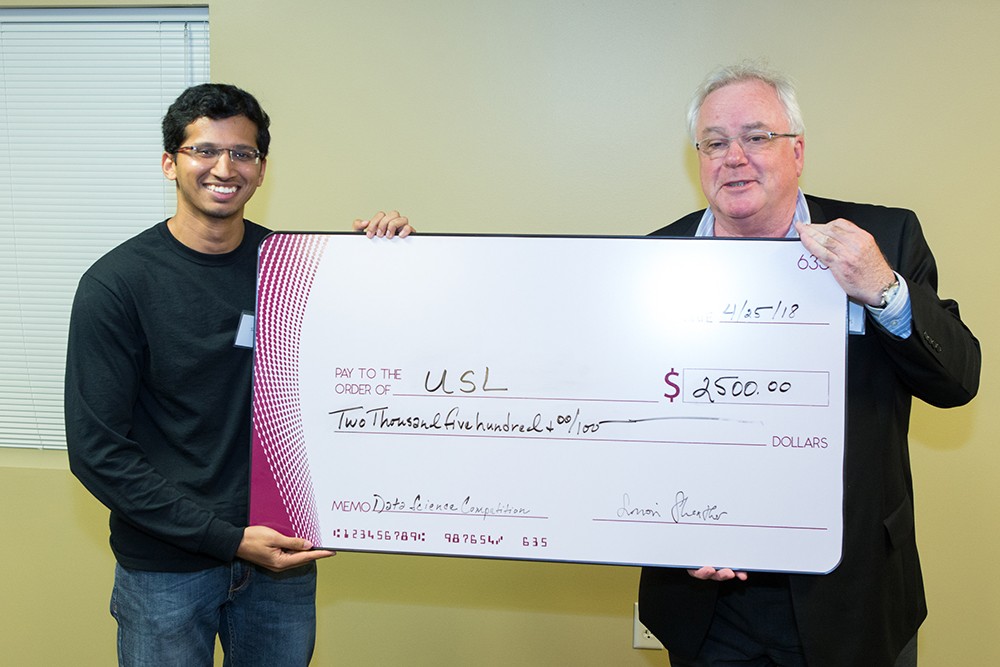
Six teams of Texas A&M University students earned a total of $10,000 during a data science competition hosted by the Texas A&M Institute of Data Science (TAMIDS).
The competition required teams to analyze a large set of public data taken from more than 110 million Chicago taxi rides between Jan. 1, 2013, and July 31, 2017. The data included the time of day, the time and distance of each trip, the amount of the fare, and information about the pickup and drop-off locations, as well as unique identifiers for each taxi. The teams then created visualizations and predictive models to describe how hourly, daily, and weekly revenue and trips for a typical Chicago taxi have changed over both location and time. Entries were judged on the quality of models, visualizations, conclusions and presentations, as well as the degree to which the team focused on the task assigned.
Fifty teams registered for the April 25 competition and 21 teams submitted entries. The teams competed in two categories: graduate or undergraduate students. First-place teams in each category received $2,500, second $1,500 and third $1,000.
“I was delighted with the quality of the entries in both divisions of the competition,” TAMIDS Interim Director Simon Sheather said. “The winning teams in particular provided interesting insights into the extent of the reduction in revenue over time of a typical Chicago taxi.” Sheather is a professor in the Department of Statistics, College of Science.
In the graduate student category, first place went to TEAM USL’s only member, Sai Vemprala, a doctoral student in the Department of Mechanical Engineering, College of Engineering. Team Outliers 2 placed second with graduate students Nishant Barma and Savinay Narendra and junior Josiah Coad, all in the Department of Computer Science and Engineering, College of Engineering, and Erica Metheney, a doctoral student in the Department of Statistics, College of Science. Third place went to the members of Team Earthquakers, doctoral students Min Li, Dunyu Liu and Bin Luo, all in the Department of Geology and Geophysics, College of Geosciences.
In the undergraduate student category, The Dream Team won first place with senior Jose Alfaro and junior Steven Broll, Department of Statistics, and senior Kevin Chou, Department of Mathematics, all in the College of Science. Second place went to the members of Team Cabish, senior Blake DeBenon, Department of Computer Science and Engineering, and senior Ryan Rudd, Department of Industrial Engineering, both in the College of Engineering. The Outliers placed third with seniors Anthony Hoang, Ashley Johnson and Sergio Ramirez Contreras, all in the Department of Engineering Technology and Industrial Distribution, College of Engineering.
The panel of judges included Sheather; Dilma Da Silva, Ford Motor Company Design Professor and head of the Department of Computer Science and Engineering, College of Engineering, and interim deputy director at TAMIDS; and Nick Duffield, professor, Department of Electrical and Computer Engineering, College of Engineering.
In addition, the panel comprised four representatives from industry: Chris Legg, subsurface information manager, BP; Charles Lindsay, senior statistician and software developer, StataCorp; Nathaniel Litton, national manager of data science, Toyota Motor Corporation; and Karen Richards, president and CEO, Fidelis Companies.
About the Texas A&M Institute for Data Sciences: TAMIDS serves and fosters collaborations across the University and its affiliated agencies. TAMIDS is a joint undertaking of Texas A&M University with the Texas Engineering Experiment Station and Texas A&M AgriLife Research. TAMIDS is an inclusive umbrella organization for data science and will facilitate synergistic interactions among researchers in diverse application areas and those with expertise in core methodologies, including computing, statistics, modeling and simulation, optimization, programming, applied mathematics, data communication, visualization, curating and archiving, and information extraction and management.
About Research at Texas A&M University: As one of the world’s leading research institutions, Texas A&M is at the forefront in making significant contributions to scholarship and discovery, including that of science and technology. Research conducted at Texas A&M represented annual expenditures of more than $905.4 million in fiscal year 2017. Texas A&M ranked in the top 20 of the National Science Foundation’s Higher Education Research and Development survey (2016), based on expenditures of more than $892.7 million in fiscal year 2016. Texas A&M’s research creates new knowledge that provides basic, fundamental and applied contributions resulting, in many cases, in economic benefits to the state, nation and world. To learn more, visit http://research.tamu.edu.
###
Media Contact: Rusty Cawley, rcawley@tamu.edu, (979) 458-1475.



